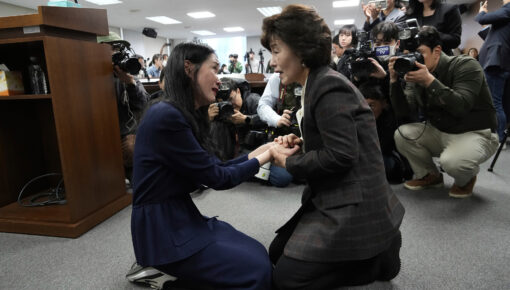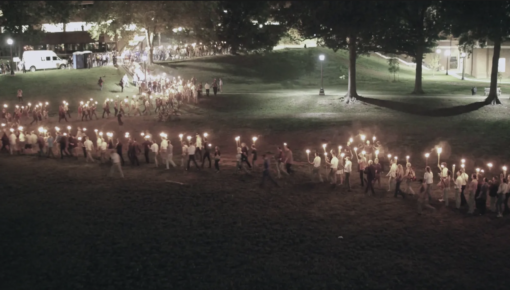The U.S. and North Korea On The Brink: A Timeline

People in South Korea's capital watch a report about a North Korean missile launch on September 15, 2017. (Chung Sung-Jun/Getty Images)
In 2018, President Donald Trump became the first sitting U.S. president to meet with a North Korean leader when he held a summit with Kim Jong Un in Singapore. At the conclusion of the meeting, Trump predicted that the two leaders would have “a terrific relationship.”
The surprising amity and dialogue came after a tense period in 2017, when the two leaders exchanged insults and threats as North Korea carried out a series of missile and nuclear tests. Less than a year after Trump called Kim “rocket man” and warned that the U.S. would “totally destroy North Korea” if it had to defend itself or its allies, he said the North Korean leader was “very honorable” and “very open.”
This cycle of threats, talks and weapons tests is familiar territory for the United States and North Korea. Here, we examine the turbulent history between the two countries.
Early Ambitions
North Korea’s quest for a nuclear weapon can be traced back decades to the Korean War.
“They felt that they needed to develop a capability that would deter an American attack,” said Duyeon Kim, a visiting senior fellow at the Seoul-based Korean Peninsula Future Forum.
The fear was not unfounded. In 1950, President Harry Truman said there was “active consideration” of using the atomic bomb in the conflict. “Ever since the Korean War, they always assumed that Washington would attack them any day and wipe them out,” Kim said. “The only way for them to survive and not get attacked would be to develop the most powerful weapon on Earth, which would be the nuclear bomb.”
With the help of the Soviet Union, North Korea began work on a nuclear complex, and in the early 1980s, built its first power plant, Yongbyon.
In these early days, Pyongyang insisted that its aims were peaceful. It became party to the Nuclear Nonproliferation Treaty (NPT) in 1985, and signed an agreement in 1991 with its rival South Korea in which both countries agreed not to produce or use nuclear weapons. But as the International Atomic Energy Agency (IAEA) pressed for access to the North’s nuclear waste sites, the country warned that it would withdraw from the NPT.
1994-2001: Clinton Tries for a Deal
In early 1994, North Korea threatened to reprocess fuel rods from its nuclear reactor, a step that would give it enough weapons-grade plutonium for five or six nuclear weapons. The Clinton administration considered various responses, including a strike on the Yongbyon facility, but eventually chose to negotiate with Pyongyang. Amid the crisis, Kim Il-sung — the founding dictator of North Korea, who ruled for more than four decades — died. His son, Kim Jong Il, took over as leader.
By October 1994, negotiations resulted in a deal known as the Agreed Framework. Under the framework, North Korea agreed to freeze and eventually dismantle its nuclear facilities, in exchange for a move toward normalizing relations with the United States. North Korea would also receive shipments of fuel oil and assistance with constructing light-water reactor power plants (which would have safeguards to ensure that fuel could not be diverted to weapons).
“The North Koreans agreed to the deal because there was a shift in the geopolitical situation in the late 1980s, early 1990s,” said Joel Wit, a senior fellow at the U.S.-Korea Institute at the Johns Hopkins School of Advanced International Studies and one of the negotiators of the Agreed Framework.
“First of all, they lost the Soviet Union as their main ally, and secondly, the Chinese were shifting towards establishing better relations with South Korea,” Wit said. “And so the North Koreans made a strategic decision that if they could secure better relations with the United States, they were willing to pay the price. And the price was, of course, their nuclear program.”
North Korea shut down its nuclear reactor, and stalled construction of two others. In 1998, it test-fired an intermediate-range missile — the Taepo Dong-1, with an estimated range of 900 to 1,800 miles — that failed. Nevertheless, negotiations kept on. North Korea agreed to a moratorium on testing medium- and long-range missiles as long as talks with the U.S. continued.
Madeleine Albright, then the secretary of state, visited North Korea’s capital in 2000 and met Kim Jong Il. The North Koreans hoped Clinton would also visit before he left office, moving North Korea and the United States closer to normalizing relations. But time ran out with the end of the Clinton presidency.

2001-2003: The Framework Collapses
When President George W. Bush took office in 2001, his administration took a more hardline approach to North Korea, postponing talks and expressing skepticism about whether Pyongyang was adhering to the Agreed Framework. North Korea warned Washington that such tough talk would force it to “strongly react.”
Bush listed North Korea among one of three nations in an “axis of evil” in his 2002 State of the Union. Later that year, in October, the administration said that North Korea was secretly enriching uranium – a claim Pyongyang denied. A month later, the fuel oil shipments agreed to under President Clinton were suspended. By the end of 2002, North Korea ordered IAEA inspectors out of the country. The Agreed Framework had collapsed.
Experts have described this period as a missed opportunity. Had North Korea not begun enriching uranium, they say, and had the U.S. moved faster to implement its portion of the agreed framework — including the construction of light-water reactors — things may have gone differently. The Bush administration, said Wit, “thought they could bully the North Koreans into stopping cheating.”
By January 2003, the relationship hit a new low with North Korea’s official withdrawal from the Nonproliferation Treaty. Four months later, U.S. officials said North Korea admitted to having at least one nuclear weapon.
2003-2006: Six-Party Talks Begin
The Bush administration would re-engage with North Korea later in 2003, joining South Korea, Japan, Russia and China in what came to be known as the Six Party Talks.
The talks produced a joint statement in 2005 in which North Korea once again agreed in principle to give up its nuclear weapons program, rejoin the Nonproliferation Treaty and accept IAEA inspections, while maintaining that it had the right to peaceful nuclear energy.
In exchange, the five other countries agreed to energy assistance and to discuss giving North Korea light-water reactors “at an appropriate time.” The U.S. and South Korea said they would not deploy nuclear weapons on the Korean Peninsula, and the U.S. and Japan said they would move toward normalizing relations.
However, progress was short lived. In July 2006, North Korea — angered by U.S. targeting of its financial assets and the pace of the light-water reactor project — broke its 1999 moratorium on testing medium- and long-range missiles. It launched seven ballistic missiles, including the long-range Taepo Dong-2, which if perfected, would have the ability to hit Alaska. The missile failed.
“Under Kim Jong Il’s rule, a useful way of understanding the dynamics of North Korea and the U.S. is the idea of cycles,” says Jung H. Pak, a senior fellow at the Brookings Institution’s Center for East Asia Policy Studies. “North Korea comes to dialogue, then retracts, using the U.S.’s ‘hostile policy’ as an excuse to conduct missile or nuclear tests, then re-enters dialogue to dampen sanctions implementation or reduce tension.”
2006: A First Nuclear Test
In October 2006, the situation reached a dangerous new stage with North Korea’s first nuclear test. The explosion yielded less than a kiloton, per the Nuclear Threat Initiative. For comparison, the atomic bomb that devastated Hiroshima was 15 kilotons.
The United Nations responded swiftly with a resolution requiring North Korea to stop testing nuclear weapons and to abandon its missile program. In response, a representative for the regime said the nuclear test was “entirely attributable to United States threats, sanctions and pressure.” He accused the Bush administration of responding to North Korea’s “patient and sincere efforts with sanctions and blockades.”
The regime’s rhetoric aside, the Six Party talks began to show dividends. In July 2007, North Korea shut down its nuclear facilities at Yongbyon, a move confirmed by a visiting IAEA team. It also agreed to disable the facilities, which would make it harder to restart them. In return, it would receive fuel oil and be removed from the U.S. list of state sponsors of terrorism. However, disagreements on how to verify North Korea’s actions once again led to stalemate.

2009: A Second Nuclear Test
President Barack Obama began his first term with an inaugural address telling “leaders around the globe who seek to sow conflict” that “we will extend a hand if you are willing to unclench your first.”
Just three months later, North Korea launched a Unha-2 rocket with the goal of putting a satellite in space. The U.S. and its allies had warned Pyongyang they would consider the launch a violation of U.N. resolutions.
The launch failed, and the Security Council again tightened sanctions. Pyongyang, in turn, said it would no longer adhere to any agreements from the Six Party talks and threatened to reactivate its nuclear facilities. Days later, it ordered IAEA inspectors out of the country.
Then, on May 24, North Korea conducted its second underground nuclear test, estimated to measure four kilotons, according to the Nuclear Threat Initiative. In a statement, it said the test helped “settle the scientific and technological problems” in increasing the power of its nuclear weapons.
Again, sanctions followed — first from the U.N. Security Council and then the U.S. By the fall of 2011, Pyongyang hinted that it would be willing to resume multilateral talks, but then suddenly, North Korean leader Kim Jong Il died in December, after holding power for 17 years. His youngest son, Kim Jong Un, was named North Korea’s leader.
2012-2016: Testing Accelerates
The pace of ballistic missile tests and nuclear tests would significantly escalate under Kim Jong Un.
Despite agreeing to a moratorium on nuclear and long-range missile tests with the Obama administration in February 2012, North Korea once again attempted a space launch with the Unha-3 that April. But the test was a failure — the rocket disintegrated shortly after launch. The U.S. halted food aid in response.
In December 2012, North Korea tried again, this time successfully launching the Unha-3 rocket and putting an object into orbit for the first time in its history. It maintained that the launch was for peaceful purposes. The rocket was similar in design to a missile that could possibly carry a warhead as far as California. The U.N. Security Council passed a new resolution a month later, condemning the launch and expanding travel bans and asset freezes for certain individuals and organizations.
The international response would do little to slow the new leader’s nuclear ambitions. Between 2013 and 2016, North Korea held three more nuclear tests, each more powerful than the last. In September 2016, North Korea claimed to test its first hydrogen bomb, a claim that experts greeted with skepticism. It also continued to make strides in its ballistic missile program.
North Korea used the nuclear and missile tests to establish “strategic relevance in the region,” according to Pak. “We can’t underestimate how North Korea was devastated during the Korean War, so the Kim family’s goal is to ensure the country’s survival, but also their own survival.” The missile program, she noted, was “for all of those things — deterring the U.S., deterring South Korea, deterring Japan.”
2017: A War of Words with Trump
In 2017, North Korea reached two significant milestones. It successfully test-fired its first intercontinental ballistic missiles in July, capable of reaching Alaska. It once again claimed to successfully test a hydrogen bomb. Whether it was indeed a hydrogen bomb has not been confirmed, but its nuclear test in September was recorded as North Korea’s most powerful yet at an estimated 250 kilotons.
When he addressed the U.N. General Assembly in September, Trump said that if the U.S. was forced to defend itself or its allies, it would have “no choice but to totally destroy North Korea.” Referring to Kim Jong Un as “rocket man,” Trump said the North Korean leader was “on a suicide mission for himself and for his regime.”
Kim responded to Trump’s speech by calling the U.S. president “mentally deranged” and warning that he would “pay dearly” for threatening to destroy North Korea. He also said Trump’s comments “have convinced me, rather than frightening or stopping me, that the path I chose is correct and that it is the one I have to follow to the last.”

“I think North Korea has typically responded to threats with threats, to provocations with provocations,” said Kelsey Davenport, director for nonproliferation policy at the Arms Control Association. “In part, North Korea is responding to the dangerous and bellicose rhetoric of President Trump.”
Still, Davenport sees an opening for negotiations, noting that North Korea has said it would not negotiate while under hostile threat. “I read that as keeping the door open for negotiations, if the United States rolls back its more hostile posturing and rhetoric.”
2018-2019: An Opening for Talks
As his country prepared to host the Winter Olympics, South Korean President Moon Jae-in reached out to North Korea — inviting athletes from the North to march with their Southern counterparts in the opening ceremony under one flag. Kim Jong Un accepted the invitation and sent his sister as a representative. The détente offered an opening, and a senior North Korean official who attended the closing ceremony indicated that the North was willing to talk with the U.S.
In early March, news broke that Kim Jong Un had invited President Trump to meet for negotiations about North Korea’s nuclear program. The White House said President Trump had accepted the invitation, and he tweeted that the North Korean leader spoke to South Korean representatives about denuclearization, not just a freeze. He continued, “Great progress being made but sanctions will remain until an agreement is reached. Meeting being planned!”
In mid-April, Trump confirmed reports that CIA Director Mike Pompeo made a top-secret trip to meet Kim Jong Un in North Korea in late March, the highest-level contact since Albright visited in 2000. The meeting came shortly after Pompeo was nominated for secretary of state.
On April 20, North Korea announced that it would suspend nuclear and missile testing, and shut down the site where its six previous nuclear tests were carried out.
In early May, Trump announced a date and location for the anticipated summit: Singapore on June 12th. Less than a week later, the plan was thrown into question when North Korea issued an angry rebuke to remarks by Trump’s new national security adviser, John Bolton. Bolton had suggested the U.S. plan to denuclearize North Korea might follow the “Libya model.” (In 2003, Libyan leader Muammar Qaddafi gave up his nascent nuclear program in exchange for sanctions relief. He was brutally killed a few years later by U.S.-backed rebels.) After Bolton’s statements, North Korea said it would have to “reconsider” its participation in the summit.
Vice President Mike Pence weighed in on May 21, saying in a televised interview: “This will only end like the Libyan model ended if Kim Jong Un doesn’t make a deal.” North Korea responded a few days later with a furious statement from Vice Foreign Minister Choe Son-hui, calling Pence’s remarks “unbridled and impudent.” She once again cast doubt on North Korea’s participation in the summit if the U.S. “clings to unlawful and outrageous acts.”
On May 24, President Trump cancelled the summit, citing the “tremendous anger and open hostility displayed in your most recent statement.” But he seemed to leave the door open to future dialogue, thanking North Korea for releasing American hostages and writing, “If you change your mind having to do with this important summit, please do not hesitate to call me or write.”
After a White House visit from Kim Jong Un’s top deputy and former spymaster Kim Yong-chol on June 1, Trump said the summit was back on.
The unprecedented meeting between a sitting U.S. president and a North Korean leader took place on June 12 in Singapore.
President Trump and Kim Jong Un shook hands, and the statement they signed said Trump “committed to provide security guarantees” to North Korea, and Kim “reaffirmed his firm and unwavering commitment to complete denuclearization of the Korean Peninsula.” The statement was short on specifics, but said more negotiations between North Korean officials and Secretary of State Mike Pompeo would be held “at the earliest possible date.”
“We had a historic meeting and decided to leave the past behind,” Kim told reporters while sitting next to Trump.
“We’re very proud of what took place today,” Trump said, after both men signed the statement. “I think our whole relationship with North Korea and the Korean Peninsula is going to be a very much different situation than it has in the past.”
Media reports noted that the language about disarmament in the statement was similar to agreements in 1994 and 2005 that eventually faltered.
Trump also made what appeared to be a major concession to North Korea, suspending joint military exercises with South Korea, saying the exercises were expensive and “very provocative.”
Trump and Kim held a second summit in Vietnam that began on February 27, 2019. After two days of talks, the leaders failed to reach an agreement. The American president said Kim wanted all sanctions on North Korea lifted, but didn’t offer sufficient dismantling of the country’s nuclear program in exchange.
“Sometimes you have to walk,” Trump said. In a press conference after the summit, he said, “They were willing to denuke a large portion of the areas that we wanted, but we couldn’t give up all of the sanctions for that.” He said Kim pledged to continue holding off on missile and nuclear tests. Trump left the door open to further talks, saying his relationship with Kim was very strong and adding, “I trust him.”
A statement from a North Korean official after the summit said the North wanted only “partial” relief from sanctions in exchange for dismantling “all the nuclear material production facilities” at the country’s main nuclear site at Yongbyon.
This post was originally published on Oct. 4, 2017.





